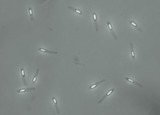Endospore
An endospore is a structure made by bacteria for survival purposes. Bacteria turn to endosporea when they undergo stress, such as an increase in heat or lack of nutrients. This process is known as sporulation. Endospores are small, rounded, resting cells that form inside bacteria when conditions become unbearable. They have a tough coating which makes it resistant to radiation (like X-rays and UV light), chemicals, heat, salt concentration and extreme pH. Endospores have calcium dipicolinate in them, which keeps the DNA stable. It is not fully understood what causes it to be so resistant.[1]
A bacterial cell will make an endospore when it is low on food so it can survive until there is more food available in the environment. An endospore will actually contain all of the important parts of the bacterial cell, such as its DNA. Only two genera of bacteria can undergo sporulation to form endospores. They are the Bacillus and Clostridium species. Bacteria that can form endospores but are not in the endospore state are known to be in their vegetative state.
Endospores are highly dangerous bio-terrorist weapons. This is because they are smaller than the vegetative state. A bacterium, in itself, is already smaller than a eukaryotic cell. Therefore, considering the small size of endospore, a small volume of it can already contain a large quantity of it. Endospores are hard to eradicate.
The bacteria cell does fission and conjugation. Fission is a form of reproduction. Conjugation is not considered reproduction.
Endospore Media
An endospore stain of the cell Bacillus subtilis showing endospores as green and the vegetative cell as red
Phase-bright endospores of Paenibacillus alvei imaged with phase-contrast microscopy
References
- ↑ "Bacterial Endospores". Cornell College of Agriculture and Life Sciences.




